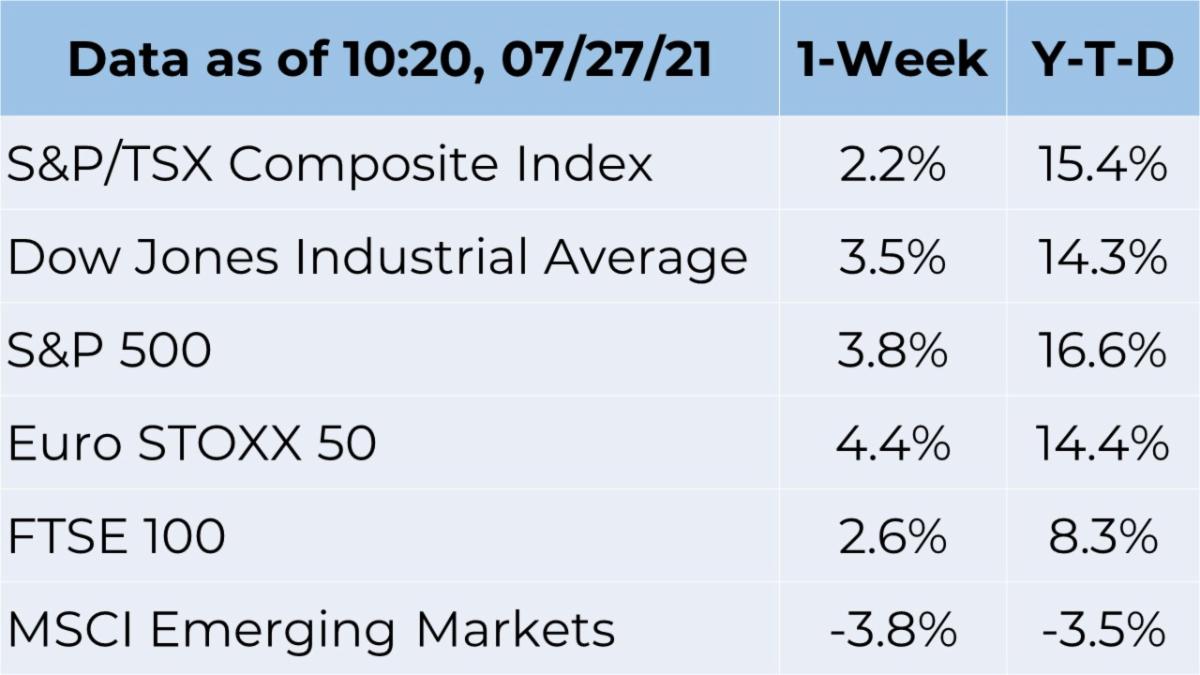Weekly Market Commentary - July 28th, 2021
The Markets
The shortest ever.
Last week, the U.S. National Bureau of Economic Research (NBER) finally announced the official dates for the recession that the coronavirus caused in 2020. Economic activity peaked in February 2020 and bottomed in April 2020. That makes the pandemic recession the shortest in American history.
According to the NBER, “The recent downturn had different characteristics and dynamics than prior recessions. Nonetheless, the committee concluded that the unprecedented magnitude of the decline in employment and production, and its broad reach across the entire economy, warranted the designation of this episode as a recession, even though the downturn was briefer than earlier contractions.”
Since then, the United States’ economy has accelerated like a sports car on the autobahn, leading the developed world in the race toward economic recovery. Compared with here in Canada, the difference is stark; while the Americans have been leading the pack in terms of economic recovery, Canada, on the other hand, has been among the worst performers in the developed world. That said, the U.S. economy faces the following obstacles that may result in a sharp deceleration:
Inflation. A shortage of goods triggered inflation. Consumers have noted some price hikes, although others are less obvious. Makers of cereal, snacks, candy, and other products, are offering unchanged packages, priced as usual, that hold smaller quantities of product, reported Axios. The technique is known as “shrinkflation”.
The end of pandemic policies. Enhanced unemployment benefits in the U.S. end in September, and the national moratorium on evictions ends in late July. The latter was the first of its kind and no one is certain how unwinding it will affect the economy, reported The Economist. Almost 36 percent of American adults are living in households that are behind on rent or mortgage payments, according to the latest Household Pulse Survey. At the same time, businesses have had trouble finding staff, with some arguing that the enhanced unemployment benefits are causing people to decide not to go back to work.
While risks to economic growth persist, the earnings of publicly traded companies are strong. So far, 24 percent of the companies in the S&P 500 index, which mainly contains U.S. companies, have reported second quarter earnings. Year-to-year blended earnings growth has been stellar, in part, because of how bad things were during the second quarter of last year, reported John Butters of FactSet.
Net profit margins, which could have been trimmed by inflation, are currently 12.4 percent. That’s the second highest level since FactSet began tracking data in 2008. Analysts anticipate profit margins will average 12 percent through the end of 2021.
Last week, major North American stock indices finished higher. The yield on 10-year U.S. Treasuries and Government of Canada bonds closed higher, too.

Source: Refinitiv
If you haven't replied to our survey already, could you please spare three minutes of your day, we would love to hear from you.
What are your hobbies and interests? Would you attend an event focused on such topic? Click below and let us know

How much are Olympic medals worth?
The Tokyo Organizing Committee of the Olympic and Paralympic Games took a new approach to producing medals. “Approximately 5,000 medals have been produced from small electronic devices that were contributed by people all over Japan…From the procurement of the metals to the development of the medal design, the entire country of Japan was involved in the production of the medals for the Tokyo 2020 Games – a project that was only possible with the participation of people across the nation.”
The current medal format – awarding gold, silver and bronze medals to the top finishers in each event – was introduced during the 1904 Olympics. For a few years, around that time, the medals were made of gold, silver and bronze, but that’s no longer the case. The medals awarded at the Tokyo Games are composed of a variety of metals.
Olympic gold. The gold medal contains 550 grams of silver ($490) covered in 6 grams of gold plating ($380). That puts its monetary value at about $870.
Olympic silver. The silver medal is made of pure silver. At the 2020 Olympics, the medal weighs in at about 550 grams, and its value is about $490.
Olympic bronze. The bronze medal is comprised of 450 grams – almost a pound – of red brass. Red brass is 95 percent copper and 3 percent zinc, and is valued at about $2.40 a pound. The medal’s monetary value is about $2.40.
Of course, the real answer to the question about the value of Olympic medals is that they are priceless. The achievement they represent – becoming one of the world’s best athletes in a sport – has a value that cannot be measured in dollars and cents.
Weekly Focus - Think About It
“Never underestimate the power of dreams and the influence of the human spirit. We are all the same in this notion: The potential for greatness lives within each of us.”
– Wilma Rudolph, Four-time Olympic medalist
Best regards,
Eric Muir
B.Comm. (Hons.), CIM®, FCSI
Portfolio Manager
Tracey McDonald
FCSI, DMS, CIM®
Portfolio Manager

